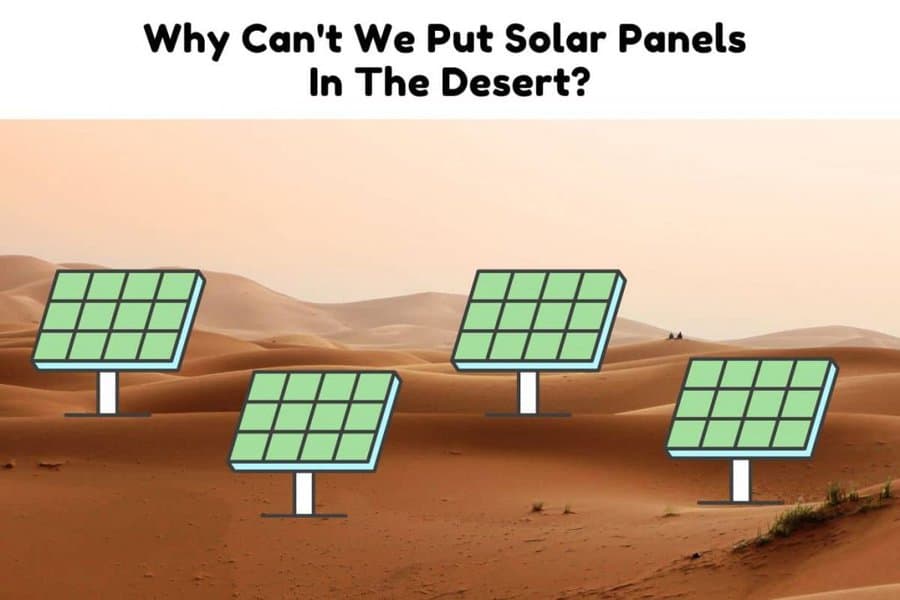Earth’s land surface is roughly 55 million square miles. Just over one-third is sparsely populated desert. By 2050, electricity demand will have tripled.
In just six hours a desert can receive enough energy to power the world for an entire year.
So why are we not putting more solar panels in the desert? The simple answer is that it’s a combination of economics and ecology.
While the idea may seem solid in theory, it is a lot less feasible in practice. Covering the Sahara with solar panels is remotely possible but it would take a massive feat of engineering and financing.
On a side note! If you’re in need of a reliable and high-performance portable solar panel, We strongly recommend the Jackery SolarSaga 100W Portable Solar Panel (Amazon Link).
With a high conversion efficiency and foldable design, this solar panel is easy to transport and set up, making it perfect for outdoor activities like camping, hiking, and RV trips.

The US solar cell technology used in this panel ensures that you get the most efficient and reliable solar charging possible.
There is also a 60W option that is more affordable (Amazon Link)
Today we will look at why blanketing the vast empty spaces in the desert with solar panels has not taken off despite the evident potential of the idea.

What If We Covered A Desert With Solar Panels?
Covering a desert with solar panels could potentially produce enough energy to power the world. Deserts receive an enormous amount of solar energy. A day of sunlight in a desert yields up to 100 times the energy the world’s population consumes in a year.
Deserts are uniquely equipped to produce vast quantities of solar. They experience constant sunshine with little to almost no cloud cover all year around. They are huge tracts of land that are mostly uninhabited and unfit for human habitation.
These two characteristics make deserts especially attractive for building large solar plants. Falling costs and improved solar technology help to make an even stronger case for ramping up solar production in the desert.
Are There Solar Panels In The Desert?
There are over 60 major solar power plants with a capacity of over 200 megawatts across the world. Several of these projects are located in deserts like the Mojave and Nevada in the U.S and the Sahara in Africa.
Solar power plants are large utility-size energy plants. They produce from tens to thousands of megawatts and can have millions of solar panels. As they require many solar panels, solar plants take up vast spaces which is why many are located in the desert.
The Copper Mountain Solar Facility in the Nevada desert produces more than 800 megawatts of energy. It is the largest solar plant in the U.S but is only the 13th largest in the world.
Located in the Tengger desert in China, the Tengger Desert Solar Park covers almost 23,000 miles. With a capacity of 1.5 gigawatts, the plant is the fifth largest in the world and provides energy to over 600,000 homes. Source
Not all solar power plants use solar panels nor are they all located in the desert. Some use mirrors to produce electricity. Mirrors concentrate energy from the sun to heat water to steam that is used to run turbines that generate electricity. This is what is known as concentrated solar power.
Some solar plants are built on water bodies like lakes. These are floating solar farms with one such example being the Alqueva floating solar farm. Built on an artificial lake, the farm has a 7.5-gigawatt capacity and will supply about 1,500 homes with energy when it officially comes online. Source
Can We Cover The Sahara Desert With Solar Panels?
Covering the Sahara with solar panels is remotely possible but it would take a massive feat of engineering and financing. There are several reasons why it would make sense to do so. The primary reason to do it would be that there is no other place on earth that receives as much solar energy.
Making up 8% of the world’s land mass, the Sahara is the largest desert on earth. Spanning 11 African countries, it is almost as big as China.
With a population of fewer than 3 million people, much of the Sahara is space. Unlike what typically happens with building a hydroelectric dam, there would be no need to displace human inhabitants to make room for solar panels.
Located along the tropic of cancer the sun is always directly overhead. Cloud cover is virtually non-existent and it receives more than 4 times the amount of solar energy as Germany does.
Covering the Sahara in solar panels would not be necessary as that would produce energy over what we need. It would produce 1.7 million terawatts of energy.
Seven times more than we need !
Realistically speaking we would only need to cover 1.2% of the Sahara in solar panels to produce enough energy for the world. That much energy would go a long way in reducing carbon emissions and meeting the escalating demand for electricity. So, are there any solar panels in the Sahara?
Built for $3.9 billion, the Noor Complex in Morocco is the largest concentrated solar power plant in the world. Located on the edges of the Sahara, the Noor has over half a million mirrors that produce up to 370 gigawatts. That is enough to provide power to over a million homes. Source
If deserts produce so much energy and potentially solve the carbon crisis, why are we not rushing to build more solar farms?
Why Don’t We Cover The Sahara Desert With Solar Panels?
The biggest obstacles to covering the Sahara in solar panels are infrastructure, the expense, the economic return, and the environmental implications. It would be massively expensive to undertake, requiring a huge investment in infrastructure with very thin financial reward. It could also be an environmental disaster.
The Sahara is so vast and so inhospitable to human habitation that there are virtually no road networks to speak of. To build anything you need a supply route to get raw materials in. Almost no roads exist in the Sahara.
To build and transport solar panels to the Sahara would require an initial investment running into the billions of dollars. Investing in transport and infrastructure raises the cost per panel from an average of around $300 to a whopping $1000. Solar power plants typically use millions of solar panels so the cost of putting solar in the Sahara would run into the trillions.
Even after the solar panels were built, transporting the energy from the Sahara to the end user would be very costly. It is difficult to transport electricity over long distances. There are energy losses that quickly eat into the profitability.
Solar panels in the Sahara would also alter its environment. The solar panels would absorb more heat and raise the temperatures. This would set off a chain reaction that would completely terraform the Sahara. This would have a butterfly effect that would be felt as far as the Amazon. The world as we know it would change dramatically.
